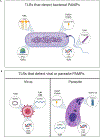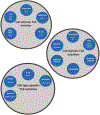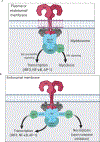Toll-like Receptors and the Control of Immunity
- PMID: 32164908
- PMCID: PMC9358771
- DOI: 10.1016/j.cell.2020.02.041
Toll-like Receptors and the Control of Immunity
Abstract
The study of innate immunity and its link to inflammation and host defense encompasses diverse areas of biology, ranging from genetics and biophysics to signal transduction and physiology. Central to our understanding of these events are the Toll-like receptors (TLRs), an evolutionarily ancient family of pattern recognition receptors. Herein, we describe the mechanisms and consequences of TLR-mediated signal transduction with a focus on themes identified in the TLR pathways that also explain the operation of other immune signaling pathways. These themes include the detection of conserved microbial structures to identify infectious agents and the use of supramolecular organizing centers (SMOCs) as signaling organelles that ensure digital cellular responses. Further themes include mechanisms of inducible gene expression, the coordination of gene regulation and metabolism, and the influence of these activities on adaptive immunity. Studies in these areas have informed the development of next-generation therapeutics, thus ensuring a bright future for research in this area.
Copyright © 2020 Elsevier Inc. All rights reserved.
Figures





Similar articles
-
Role of TLRs as signaling cascades to combat infectious diseases: a review.Cell Mol Life Sci. 2025 Mar 19;82(1):122. doi: 10.1007/s00018-025-05631-x. Cell Mol Life Sci. 2025. PMID: 40105962 Free PMC article. Review.
-
Toll-like receptor regulation of effector T lymphocyte function.Trends Immunol. 2013 Oct;34(10):511-9. doi: 10.1016/j.it.2013.06.003. Epub 2013 Jul 22. Trends Immunol. 2013. PMID: 23886621 Review.
-
Toll-like receptors are key participants in innate immune responses.Biol Res. 2007;40(2):97-112. doi: 10.4067/s0716-97602007000200001. Epub 2007 Nov 21. Biol Res. 2007. PMID: 18064347 Review.
-
The role of pattern-recognition receptors in innate immunity: update on Toll-like receptors.Nat Immunol. 2010 May;11(5):373-84. doi: 10.1038/ni.1863. Epub 2010 Apr 20. Nat Immunol. 2010. PMID: 20404851 Review.
-
[Progress of research on TLRs-mediated signaling pathway].Sheng Li Ke Xue Jin Zhan. 2011 Oct;42(5):340-6. Sheng Li Ke Xue Jin Zhan. 2011. PMID: 22242400 Review. Chinese.
Cited by
-
Cannabidivarin alleviates neuroinflammation by targeting TLR4 co-receptor MD2 and improves morphine-mediated analgesia.Front Immunol. 2022 Aug 10;13:929222. doi: 10.3389/fimmu.2022.929222. eCollection 2022. Front Immunol. 2022. PMID: 36032146 Free PMC article.
-
The RING finger protein family in health and disease.Signal Transduct Target Ther. 2022 Aug 30;7(1):300. doi: 10.1038/s41392-022-01152-2. Signal Transduct Target Ther. 2022. PMID: 36042206 Free PMC article. Review.
-
Exploring the complex immunomodulatory effects and gut defense via oral administration of Astragali radix water extract to normal mice.BMC Complement Med Ther. 2024 Oct 7;24(1):361. doi: 10.1186/s12906-024-04667-z. BMC Complement Med Ther. 2024. PMID: 39375623 Free PMC article.
-
Immunotherapy for Pulmonary Arterial Hypertension: From the Pathogenesis to Clinical Management.Int J Mol Sci. 2024 Aug 1;25(15):8427. doi: 10.3390/ijms25158427. Int J Mol Sci. 2024. PMID: 39125996 Free PMC article. Review.
-
Protein phosphatases in TLR signaling.Cell Commun Signal. 2021 Apr 21;19(1):45. doi: 10.1186/s12964-021-00722-1. Cell Commun Signal. 2021. PMID: 33882943 Free PMC article. Review.
References
-
- Akashi S, Shimazu R, Ogata H, Nagai Y, Takeda K, Kimoto M, and Miyake K. (2000). Cutting edge: cell surface expression and lipopolysaccharide signaling via the toll-like receptor 4-MD-2 complex on mouse peritoneal macrophages. J Immunol 164, 3471–3475. - PubMed
-
- Akira S, and Hoshino K. (2003). Myeloid differentiation factor 88-dependent and -independent pathways in toll-like receptor signaling. J Infect Dis 187 Suppl 2, S356–363. - PubMed
-
- Alexopoulou L, Holt AC, Medzhitov R, and Flavell RA (2001). Recognition of double-stranded RNA and activation of NF-kappaB by Toll-like receptor 3. Nature 413, 732–738. - PubMed
-
- Anders HJ (2005). A Toll for lupus. Lupus 14, 417–422. - PubMed
Publication types
MeSH terms
Substances
Grants and funding
LinkOut - more resources
Full Text Sources
Other Literature Sources
Molecular Biology Databases

